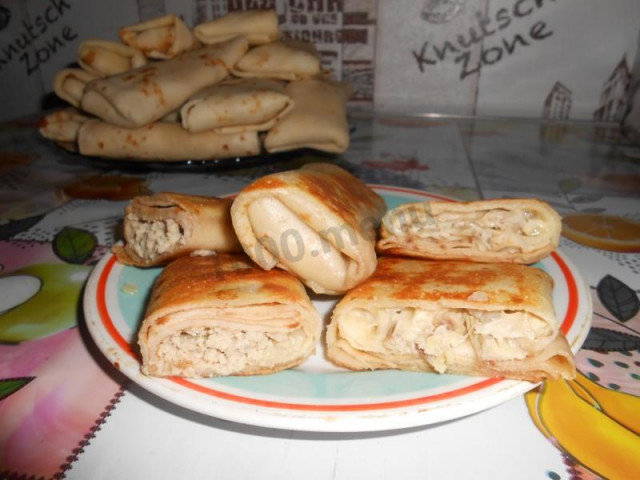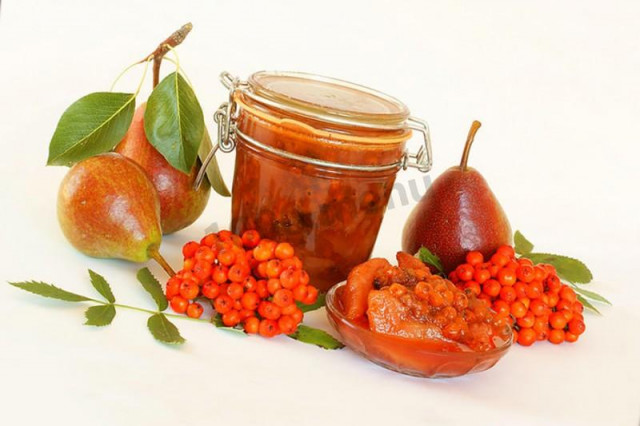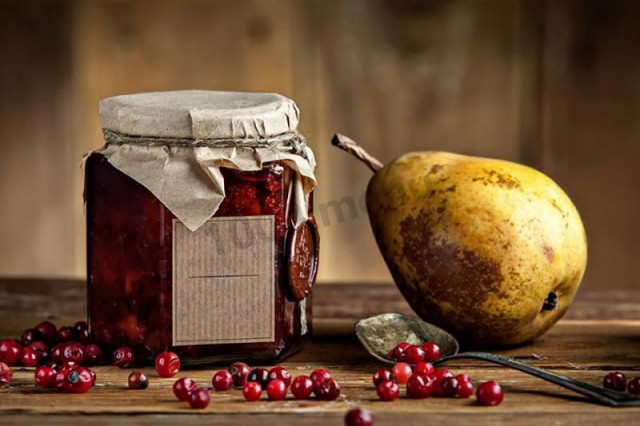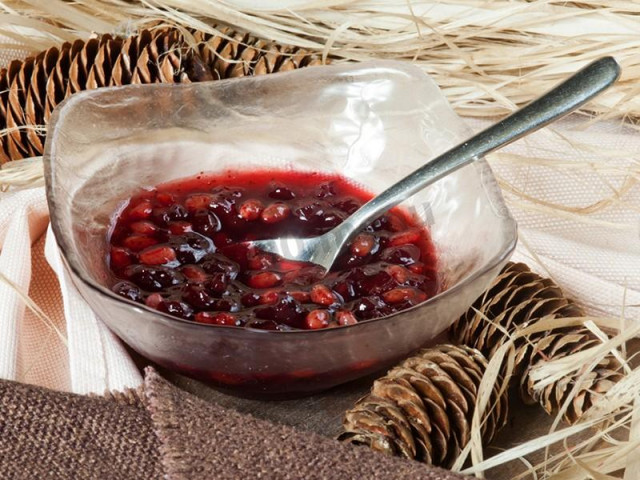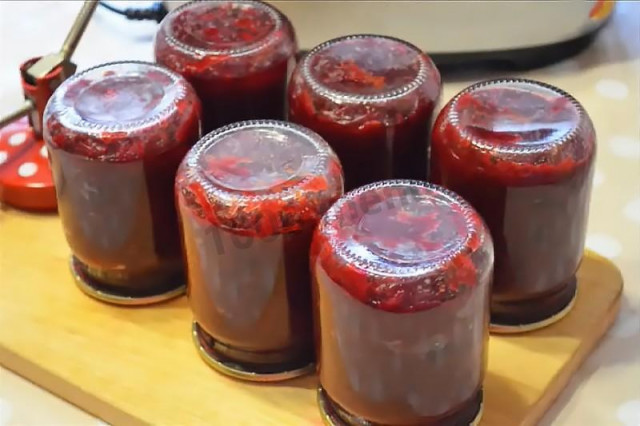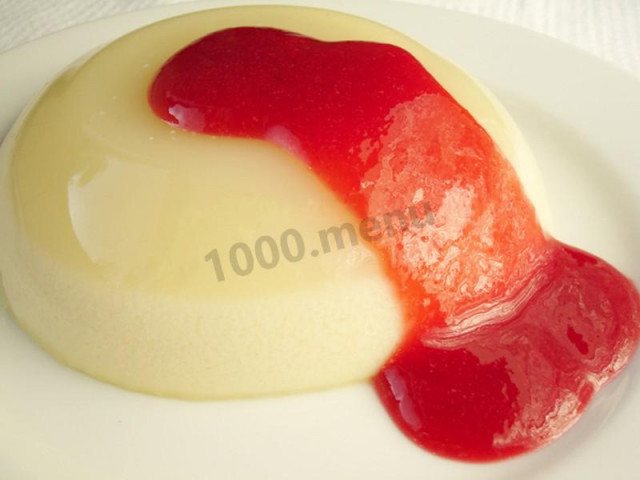Composition / ingredients
Step-by-step cooking
Step 1:
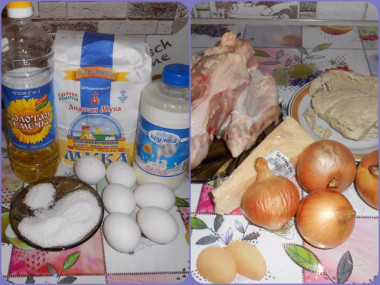
Prepare the ingredients for the dough and for the fillings. Boil chicken bones (backs, leftovers from the trimmed breast) for 1-1.5 hours until ready. The meat in my photo is already boiled, because before that I made a pickle with rice and tongue and the broth from the meat (leaving 0.5 cups for the filling) went to soup.)
Step 2:

Pork cooking: Rinse the meat, put it in boiling water, let it boil again, cover with a lid and cook for 1.5-2 hours until ready. 30 minutes before the end of cooking, you can add carrots and onions to the broth, as well as bay leaves and peppers. You need to salt pork for 10 minutes . before the end of cooking, so that the pork is juicier. note: A piece of pork weighing 0.5-1 kg. you need to cook 1.5-2 hours after boiling. Pork is cooked in pieces for 40-50 minutes .
Step 3:

Dough: Mix milk with water, add flour in small portions, mix well so that there are no lumps. Personally, to simplify and speed up this stage, I do it with a mixer.) Then beat in the eggs, add salt, sugar, vegetable oil. Mix thoroughly again until smooth. NOTE: You can safely add 800 grams of flour at once, and then, if necessary, add a little more, until you get the desired consistency - liquid sour cream. The test came out 4 liters .
Step 4:
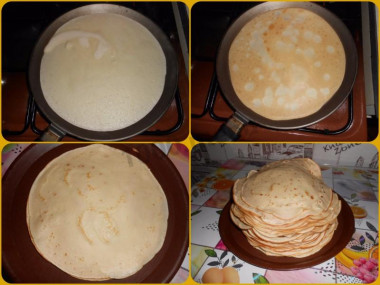
Bake thin pancakes. Without oil! (although look at the features of your frying pan). Such pancakes should be baked on a quiet fire, a little less than average, and on the one hand until golden, and on the other fry for just a couple of seconds. note: If the pancakes are torn, turn over badly, then add a little more flour. And if the dough seems thick, then you can dilute it with milk or water (just a little bit - don't overdo it;))
Step 5:
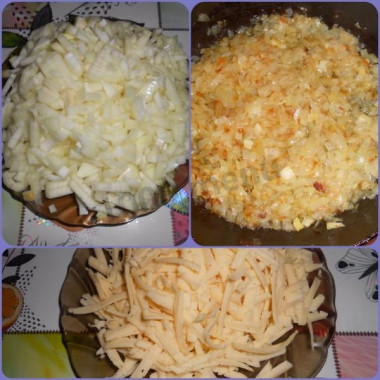
In parallel with baking pancakes, you can prepare the filling. Peel the whole onion, finely chop and fry in vegetable oil until golden. Grate the cheese on a coarse grater.
Step 6:

Twist the cooked meat in a meat grinder with a small nozzle (hot or cold - it does not matter). Add half of the fried onion and half a cup of broth to the meat, mix well. note: If the meat mixture seems a little dry, then you need to add a little more broth so that it becomes like this... "wet".)
Step 7:
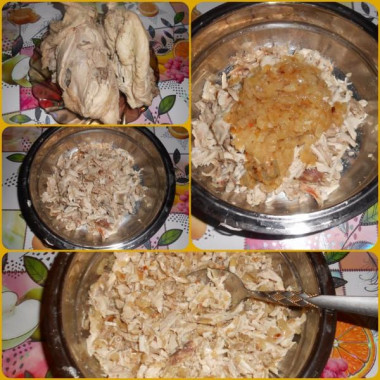
Cool the finished chicken bones / backs and separate the meat from the bones (it is better not to use the skin in the filling). Add the remaining fried onion and broth to the meat, mix well.
Step 8:
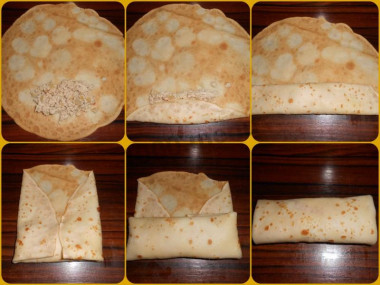
When all the pancakes have been baked (I usually have 44-48 pieces of them), we proceed to folding the pancakes. Take the meat filling and spread it on the fried (golden) side of the pancake closer to the edge of 1 tbsp. l. Roll twice into a tube, wrap the side edges (left and right), but so as not to overlap, and roll further into a tube. Do this with half of the pancakes.
Step 9:
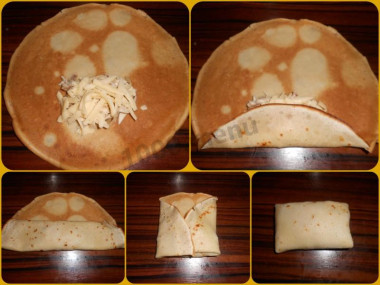
Now proceed to the second filling. But, since there are two types of fillings, it means that the pancakes need to be somehow different.. Therefore, pancakes with chicken filling will be wrapped a little differently - making them more square. To do this, we also spread the filling on the fried side, but already away from the edge and more square (also 1 tbsp.l.), put a little cheese on top. Roll up also twice, then wrap the side edges, but already in overlap, and return to the end.
Step 10:
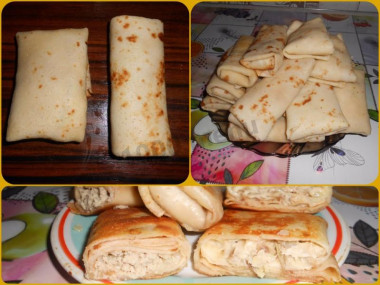
As a result, as you can see in the photo, the pancakes can be distinguished!) In this form, put them neatly in a saucepan and store them in the refrigerator until you eat them. Pancakes are stored for 4-5 days. Well, just before use, they should be fried under the lid on both sides until golden brown. But fry on low heat, otherwise the pancake will fry, and the filling will not have time to heat up. This time I got 46 pancakes - 24 with meat, 20 with chicken and 3 were eaten with
IMPORTANT: Pork should be cooked on very, very low heat so that the movement of the broth is slightly noticeable from above. Otherwise, the meat will turn out to be harsh.
Caloric content of the products possible in the composition of the dish
- Category I chicken - 238 kcal/100g
- Chicken of the II category - 159 kcal/100g
- Chicken, flesh without skin - 241 kcal/100g
- Chickens - 140 kcal/100g
- Onion - 41 kcal/100g
- Whole cow's milk - 68 kcal/100g
- Milk 3.5% fat content - 64 kcal/100g
- Milk 3.2% fat content - 60 kcal/100g
- Milk 1.5% fat content - 47 kcal/100g
- Concentrated milk 7.5% fat content - 140 kcal/100g
- Milk 2.5% fat content - 54 kcal/100g
- Chicken egg - 157 kcal/100g
- Egg white - 45 kcal/100g
- Egg powder - 542 kcal/100g
- Egg yolk - 352 kcal/100g
- Ostrich egg - 118 kcal/100g
- Pork fat - 333 kcal/100g
- Pork meat - 357 kcal/100g
- Pork - low-fat roast - 184 kcal/100g
- Pork chop on a bone - 537 kcal/100g
- Pork - schnitzel - 352 kcal/100g
- Pork Shoulder - 593 kcal/100g
- Boar's leg - 113 kcal/100g
- Pork - 259 kcal/100g
- Dutch cheese - 352 kcal/100g
- Swiss cheese - 335 kcal/100g
- Russian cheese - 366 kcal/100g
- Kostroma cheese - 345 kcal/100g
- Yaroslavsky cheese - 361 kcal/100g
- Altai cheese 50% fat content - 356 kcal/100g
- Soviet cheese - 400 kcal/100g
- Cheese "steppe" - 362 kcal/100g
- Uglichsky cheese - 347 kcal/100g
- Poshekhonsky cheese - 350 kcal/100g
- Lambert cheese - 377 kcal/100g
- Appnzeller cheese with 50% fat content - 400 kcal/100g
- Chester cheese with 50% fat content - 363 kcal/100g
- Edamer cheese with 40% fat content - 340 kcal/100g
- Cheese with mushrooms of 50% fat content - 395 kcal/100g
- Emmental cheese with 45% fat content - 420 kcal/100g
- Gouda cheese with 45% fat content - 356 kcal/100g
- Aiadeus cheese - 364 kcal/100g
- Dom blanc cheese (semi-hard) - 360 kcal/100g
- Cheese "lo spalmino" - 61 kcal/100g
- Cheese "etorki" (sheep, hard) - 401 kcal/100g
- White cheese - 100 kcal/100g
- Fat yellow cheese - 260 kcal/100g
- Altai cheese - 355 kcal/100g
- Kaunas cheese - 355 kcal/100g
- Latvian cheese - 316 kcal/100g
- Limburger cheese - 327 kcal/100g
- Lithuanian cheese - 250 kcal/100g
- Lake cheese - 350 kcal/100g
- Gruyere cheese - 396 kcal/100g
- Whole durum wheat flour fortified - 333 kcal/100g
- Whole durum wheat flour, universal - 364 kcal/100g
- Flour krupchatka - 348 kcal/100g
- Flour - 325 kcal/100g
- Granulated sugar - 398 kcal/100g
- Sugar - 398 kcal/100g
- Vegetable oil - 873 kcal/100g
- Salt - 0 kcal/100g
- Water - 0 kcal/100g
- Broth - 15 kcal/100g

